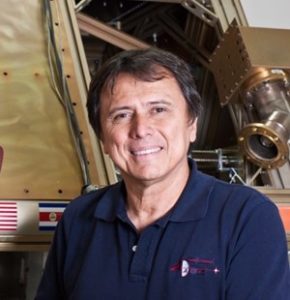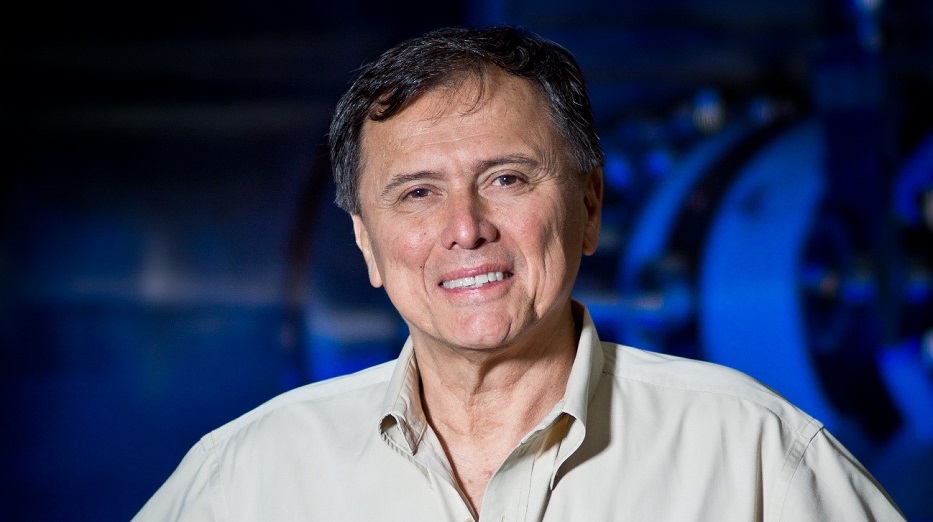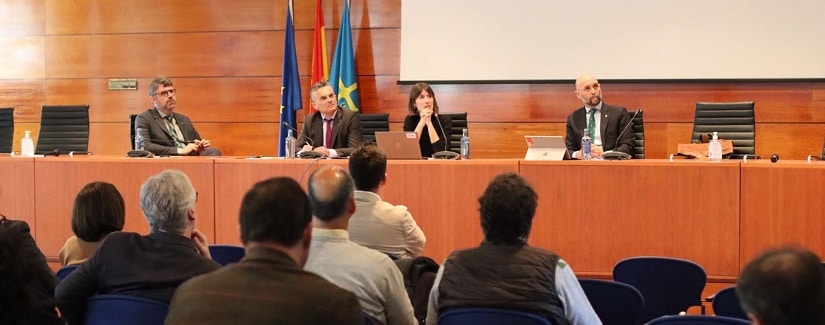After earning a degree in Mechanical Engineering and a PhD in Plasma Physics, Franklin Chang-Díaz joined NASA in the early ‘80s as the first Latin American astronaut ever. Over 25 years of active service, he completed seven space missions and spent over 1,600 hours in space. After retiring, he founded Ad Astra Rocket, an aerospace engineering company that is researching electric propulsion engines and applying these advances to public transportation in his native Costa Rica
The start of your space career dates back to the 1980s. What was the situation back then and what prospects were available?
It was the start of the space shuttle era. Flights began in 1981, but they were very infrequent, as the technology was still under development. In 1980, there were only American astronauts at NASA, except for two Europeans (Claude Nicollier from Switzerland and Wubbo Ockels from the Netherlands) who entered the program in my group, marking the start of collaboration with the European Space Agency, which had just been established. My first space flight was in January 1986. During my 25 years at NASA, I participated as an astronaut on seven missions, sharing the world record for space flights with my colleague Jerry Ross. Today, the main program consists of operating the International Space Station.
As you’ve mentioned, you completed seven space missions between 1986 and 2002. What differences would you highlight between the missions you were on and those conducted today?
The complexity of the missions increased as the techniques were perfected. There were big differences between my first mission, in January 1986, and the last, in June 2002. On the earlier missions, our training focused on completing prescribed tasks with great detail. As the missions became more complex, the focus of training changed more towards developing skills that would enable us to face many diverse contingencies. The scientific content of the missions also evolved toward greater complexity and productivity.
The VASIMRâ engine is electric and allows for a larger payload than a chemical engine, making space transport more economical”
You remain closely linked to the industry (through your company Ad Astra Rocket) and you are involved in an important project: developing an electric propulsion engine. What exactly is this plasma engine (VASIMR) and how can it improve space missions?
All rockets work in the same way: a high-temperature “fuel” is shot in one direction, moving the rocket in the other direction through the well-known action and reaction principle. In a chemical rocket, the fuel is ignited to produce the high temperature. In an electric rocket, it is not fuel, rather an inert gas that is heated with electricity by an external source (a solar panel or a nuclear reactor). This makes it possible to achieve much higher temperatures and greater efficiency, using less “fuel.” The VASIMRâ engine is electric and allows for a larger payload than a chemical engine, making space transport more economical. Because it is more frugal than the chemical engine in “fuel” consumption, the VASIMRâ engine operates for longer periods of time, so acceleration is longer and, on interplanetary flights, the velocity ends up being greater, shortening travel time. It represents a paradigm shift in space transportation.
What tests have been conducted with this technology and what were the results?
Our experimental prototype, the VX-200, has been operating – and evolving – in tests in the vacuum chamber at our laboratory for nearly 10 years. From 2010 to 2013, we fired this engine over 10,000 times at 200 kW of power with excellent results.
In 2015, under contract with NASA, we began modifications in the laboratory and in the design of the engine itself (that variant is known as the VX-200SS) so that it could operate continuously for long periods of time (hours) and demonstrate a new engine heat management system. Those tests are ongoing at this time and will continue until mid-2020. Following that milestone, we will begin construction of a new engine, the TC-1Q, which we hope to launch into space for testing around 2023.
One of the most ambitious derivative projects is a manned flight to Mars. How can this technology facilitate that?
For manned flights to that planet, the electricity needed by the engine would not come from a solar panel, but rather from a nuclear reactor and, although we are not responsible for it, that technology is being developed in parallel by other groups in the United States and other countries with nuclear capacity. With the right reactor, the VASIMRâ engine would drastically reduce voyage times to Mars, from the nearly eight months currently estimated down to three months. As the nuclear technology is perfected, it could even be less. Due to its characteristics of continuous acceleration, the greater the distance, the higher the velocity and, in that context – beyond Mars, the VASIMRâ engine could open up the entire solar system to human exploration.
What is the current stage of the project and what are the risks you anticipate in getting it underway?
Upon completion of the long-term testing, the engine would be at stage 5 on the NASA scale, which is known as the ‘Technology Readiness Level’ (TRL). Stage 6, which we would begin in 2020, represents the first test of the technology in space. There are always risks, whether technical, program-related or financial, in any innovative undertaking like ours. But the team tackles these risks with discipline and patience. As the technology matures, the risk is reduced.
What preventive measures are put in place when insuring an aerospace project of this scope?
Planning, planning, and planning. It is very important to have a well-defined roadmap with scheduled, attainable milestones that are properly budgeted. It is essential to pay attention to detail and anticipate errors, setbacks, and contingencies and to have alternative plans for handling different situations and scenarios. You have to listen to your team, take care of them, and be psychologically prepared to lead a long, continuous fight, avoiding defeatism and keeping an optimistic attitude, but without losing touch with reality.
Ad Astra Rocket Company is also tackling a project that uses hydrogen as a means of storing and producing clean, renewable energy. Could you explain to us what that consists of?
The production of hydrogen through the electrolysis of water is a way of storing energy for use when needed. If the energy used for the electrolysis is clean (solar, wind, etc.), then the process is clean. The hydrogen, stored in a tank, is combined with the oxygen in the air in electric vehicles that use electrochemical fuel cells to produce the electricity that moves them, and the water is retrieved, which also is purified in the process. In Costa Rica, electricity is quite clean. Our aim is to use hydrogen to store our abundant solar and wind energy, which we don’t take advantage of because of its intermittence. Hydrogen can replace diesel and gasoline in transportation and contribute to decarbonizing our economy, in addition to creating new jobs and new industries in the region.
Could you tell us about the implementation of this model of engine in Costa Rica’s public transportation? What stage is the project in?
In November 2017, we began the first hydrogen-based electric public transportation ecosystem in Central America. In May 2018, our bus, called Nyuti (“Star” in the Chorotega language) took the president-elect, Mr. Carlos Alvarado Quesada, and his cabinet to be sworn in in San Jose. In January 2019, in addition to the bus, in collaboration with the company Purdy Motor, S.A., Toyota distributors in Costa Rica, we introduced the Toyota Mirai, the first hydrogen-based electric sedan in Latin America, and we joined the International Partnership for Hydrogen and Fuel Cells in the Economy (IPHE), becoming co-founders of the Center for Hydrogen Safety. Today we are in the process of expanding the ecosystem to a second quick-fill hydrogen dispenser, which will be operational in mid-2020, and we have become pioneers in Latin America in hydrogen technology.
In what other sectors and businesses do you believe this technology can be implemented?
Hydrogen is relevant in all forms of transportation, including cars, buses, trucks, trains, ships, and even aircraft. It can also be used in stationary energy, in buildings, businesses, industry, and for other processes such as fertilizers, plastics, steel, cement, and heat generation. Producing hydrogen through electrolysis also generates large amounts of very pure oxygen, which is part of the value chain. The water that comes from hydrogen consumption in the production of electricity is also pure.
What trends will mark the future of the aeronautics industry? What do you believe will be the keys to its technological development?
The trend towards electrifying transportation is also filtering into aviation and the space industry. After all, the VASIMRâ engine is an electric engine. In a not-too-distant future, the heavy equipment that will help build lunar and Martian stations will be moved, not by diesel or gasoline, but by hydrogen-generated electricity. The key is not to be afraid.

Dr. Franklin Chang Díaz is Chairman and CEO of Ad Astra Rocket Company, an American company that develops advanced plasma rocket technology and applications in sustainable energy with operations in Webster, Texas and Guanacaste, Costa Rica. Dr. Chang Díaz founded the company in 2005, after a 25-year career as a NASA astronaut. A veteran of seven space missions, he has spent over 1,600 hours in space, including 19 hours on three spacewalks. In 1994, alongside his NASA astronaut training, he founded and managed the Advanced Space Propulsion Laboratory (ASPL) at the Johnson Space Center to develop the physics of the VASIMR® rocket engines. Dr. Chang Díaz has a PhD in Applied Plasma Physics from MIT and a degree in Mechanical Engineering from the University of Connecticut. He is also Adjunct Professor in Physics at Rice University and the University of Houston.




